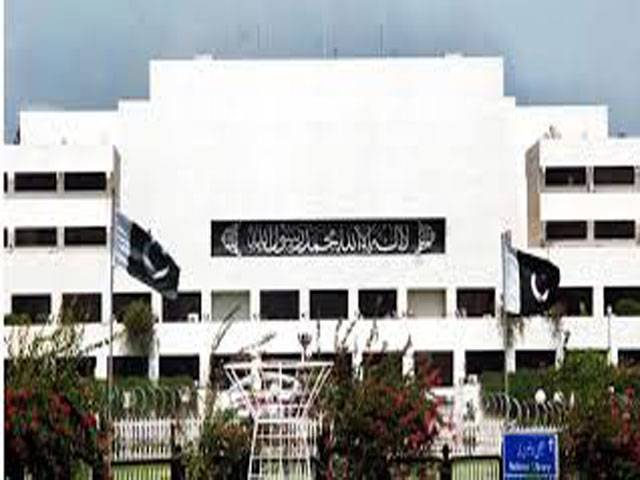ISLAMABAD - Pakistan’s first net metering project at Parliament House has started generating one MW of electricity, not only making the building loadshedding-free but also paving the way for the general consumers to become self-sufficient with one time investment.
As much as 3,940 solar panels of 255 watts each are installed on the rooftop and parking area of the parliament building, covering roughly 10,000 square meters.
At rooftop 0.3 MW electricity is being generated while at parking area static solar panels are producing 0.7 MW of electricity.
The project was initiated in April 2014, by Chinese President Xi Jinping and Prime Minister Nawaz Sharif during the former’s visit to Pakistan.
For the last two weeks, the Parliament House is generating green energy.
“We have generated 86 MW of electricity, out of which 63 MW were consumed in the house while remaining 13 MW was sold to the Islamabad Electric Supply Company,” said Project Director, Shahid Shaukat.
During winter daytime, the Parliament House consumes around 0.7MW, while at off peak hours, the requirement is 0.05-0.06 MW. In summer the consumption shoots to 01 MW.
Generally, in solar power systems, batteries are used to store excess electricity generated at daytime and stored energy is consumed during nights, but, thanks to the new metering facility, announced by National Electric Power Regulatory Authority, the excess power is supplied to the national grid with a two-way meter-recording the transaction. At the end of the monthly cycle, if Parliament House gave more electricity to the grid than it consumed, the distribution company will pay the difference.
“We could have installed batteries for backup to become total self-sufficient and could have gone totally off-grid, but the expense of batteries and its annual maintenance is too expensive,” the project director said.
After the installation of the new project, the house will now produce sufficient electricity to meet its essential requirements.
Nepra has granted a flat tariff of Rs 13.22 for the Parliament meaning that it would sell electricity to the distribution company at the same cost as it is buying.
In case the Parliament House produces more electricity and supplies to the distribution company, it would be got paid at a rate of Rs 13.22 per unit.
Presently, a Chinese company is running the system along with staff of the Parliament House but by next month the management and maintenance would be handed over to the staff of the house.
Speaker Ayaz Sadiq, the main driving force behind the project, termed the project excellent precedent for rest of the country.
Keeping in mind the vision of the prime minister and to overcome the energy crises, there is a dire need to conserve available energy and to shift to alternate energy sources. Energy conservation in the Parliament House was one of the key components of the future strategic priorities of the country, the speaker said in a message.
The officials are of the view that although the project is fully funded by the Chinese government but the project has set precedence.
In the Parliament House, China-made panels have been used whose per year depreciation has been claimed one percent only. Along with panels electronic gadgets have been used to convert DC power into alternative current. The Chinese company has also installed switches, meters and cables to connect system to national grid, by using existing IESCO transformers.
This is the first project in the country, which will sell excess electricity to the distribution company. Nepra last year had announced net metering facility for general consumers.
The first net metering license has been granted to the Parliament House for a period of three years. After the expiry date the licence will be renewed with new tariff, applicable at that time.
Nepra encourages consumers to avail net metering to end energy crisis.
Net metering have paved the way towards establishment of flexible regulatory regime where any consumer can install solar panels and sell excess electricity to concerned distribution company by following a short simple and easy process, Ayesha Tassaduq, spokesperson Nepra said.
She said that any consumer who has a 3-phase domestic, commercial or industrial electricity connection can submit application to his concerned distribution company along with necessary documents. If the distribution company is satisfied that the consumer qualifies as distributed generator, they will enter into a standard agreement.
The consumer will make payments of interconnection charges and sale-purchase of electricity would start.
Experts believe that after the completion of the pioneer project it would be now easy for general consumers to shift to solar.
“When the net metering was announced by Nepra last year, it was only policy or guidelines, there were many confusions, but now after the execution of pioneer project, we know what exactly is required, what should be the safety measures and yes now we know how to do it,” said an official of Iesco.
The businessmen are hopeful that after the launch of the first project many will opt for the alternative energy.
Sunday, May 18, 2025
Parliament House shifted to solar energy
Extra power can be sold back to distribution company

Unpacking Modi’s Sindoor speech: A trail of terror
May 18, 2025
MQM-P urges PM to ease tax burden on salaried class
May 18, 2025
-
Lahore emerges among safest global cities in Numbeo 2025 index
-
Lahore emerges among safest global cities in Numbeo 2025 index
-
India’s suspension of Indus Water Treaty legally baseless
-
Seventh polio case reported in Pakistan amid nationwide vaccination drive
-
Pakistan reports sixth polio case of 2025
-
PTA begins issuing VPN licences to regulate usage
Culture Shift
May 18, 2025
Tactical Shift
May 18, 2025
Unmasked Cruelty
May 18, 2025
India Isolated
May 17, 2025
Descent into Hell
May 17, 2025
Fostering Entrepreneurship
May 18, 2025
Behind a Promising Job Offer
May 18, 2025
Indo-Pak Wisdom
May 18, 2025
Traffic Signal at Shahzad Town
May 18, 2025
English a Measure of Intelligence?
May 17, 2025
ePaper - Nawaiwaqt
Nawaiwaqt Group | Copyright © 2025





